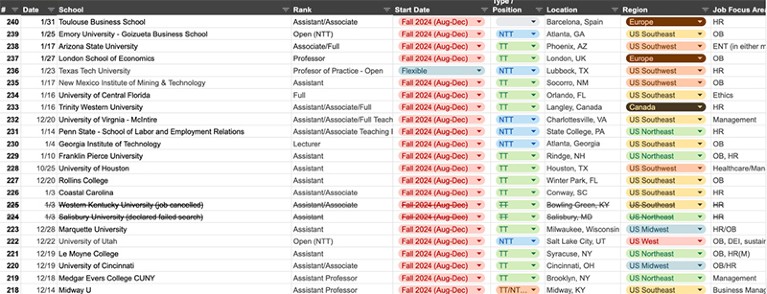
Searching for jobs can be a daunting endeavour.Credit: PA Images/Alamy
About a year ago, a colleague and I were lamenting the hardships of the academic job market. She had landed a tenure-track position at a prestigious research university the previous year. Now it was my turn. To help smooth the process, she sent me the link to a shared spreadsheet. Little did I know that it would become one of the most precious assets in my job-search toolkit — and academic life in general.
Open to anyone with the link, the spreadsheet — this year entitled ‘2023 - 2024 Management PhD job doc’ — has been passed from generation to generation among graduate students for more than a decade. Its main purpose is to provide an anonymous forum and listings board for job seekers in my field, management. Around May each year, candidates create a new spreadsheet to kick off the job-market season, but links to old spreadsheets are retained so their precious content isn’t lost to future generations.
Why two scientist-mums made a database of parental-leave policies
The spreadsheet uses a tab-based structure. Some tabs provide a question-and-answer forum on a particular area of management; a tab called Catharsis is where academics can share unsettling experiences from their work life and discuss job-market frustrations. Others list open job postings and provide status updates on contributors’ job-hunt processes. And then there’s WWW — the who went where tab, where job seekers’ names are revealed at the end of the academic year to share where they landed after their search. There are also links to useful web resources and, naturally, memes.
If that sounds similar to Slack and other messaging tools, it is. But the spreadsheet is completely anonymous. It is also incredibly flexible, quick to load and easy to search. Plus, researchers are already well versed in spreadsheets — and appreciate the ability to trawl job-search boards while looking as if they’re working.
Resource and sounding board
On a typical day, the spreadsheet has some 30–45 concurrent users, including graduate students and early-career researchers but also hiring-committee members, journal editors and members of editorial boards. This breadth and variety makes the question-and-answer process incredibly effective: users can ask a question and get multiple responses in minutes.
Users are based all over the world, and often discuss how various aspects of academic life compare between geographical locations or according to an institution’s focus — for instance, comparing research-oriented institutions with teaching-oriented or ‘balanced’ ones. Threads might include comparisons of tenure requirements, teaching loads and co-authorship etiquette.

Shared spreadsheets can provide a lightweight group chat and knowledge base for job seekers.Credit: Silvia Sanasi
For job candidates, the spreadsheet is an important source of kinship. But it serves a similar role for more senior faculty members. Users discuss everything from how to handle journal reviews to overcoming methodological or technical issues and the economics of job offers. In this way, the spreadsheet also promotes transparency, providing information about hiring conditions, expectations and compensation. It also helps to reduce ethnic and gender imbalances — because salary guidelines are made public (albeit anonymously) — and to foster awareness of standards in the marketplace.
Community outlet
The spreadsheet helped me to navigate the job market while also learning about the nuts and bolts of my field and of academic life more broadly. Among other things, I learnt how to structure my application package and answer common interview questions, and found out about salary expectations, negotiation tips and the etiquette of interacting with hiring-committee members. Those lessons helped me to land my dream job at my postdoctoral institution, which I accepted last month.
How we boosted the number of female faculty members at our institution
I also routinely consult the spreadsheet to get tips on the review process for specific journals, seek advice on how to handle difficult reviewers and simply rant about rejections. In this way, the spreadsheet makes me feel like part of a community and helps me to find resources on how to become a better researcher, (co-)author, reviewer and colleague. Whatever your field, such a forum can provide important benefits to mental health, which is often strained in academic life. It can also be invaluable for reducing the differences caused by geographical location and resource availability.
The management spreadsheet is not unique. Similar forms of collaboration exist in other domains and should be easy enough to establish in fields where they do not. The biggest challenge is critical mass: this spreadsheet grew out of one of the field’s most-attended conferences and has been promoted year after year, through doctoral consortia and word of mouth. Today, it is self-sustaining.
I hope this article can inspire scholars in other disciplines to adopt similar solutions to help researchers at all levels — from graduate students to senior faculty members — to navigate the difficult life of an academic.

 Why two scientist-mums made a database of parental-leave policies
Why two scientist-mums made a database of parental-leave policies
 How we boosted the number of female faculty members at our institution
How we boosted the number of female faculty members at our institution
 How scientists use Slack
How scientists use Slack
 Collection: Careers toolkit
Collection: Careers toolkit



